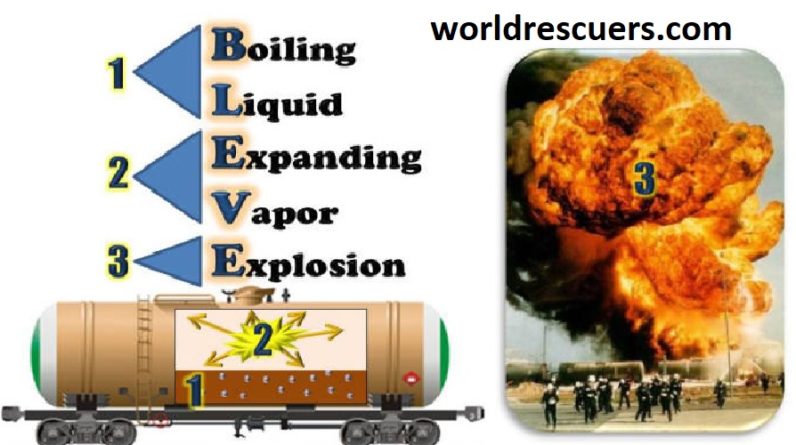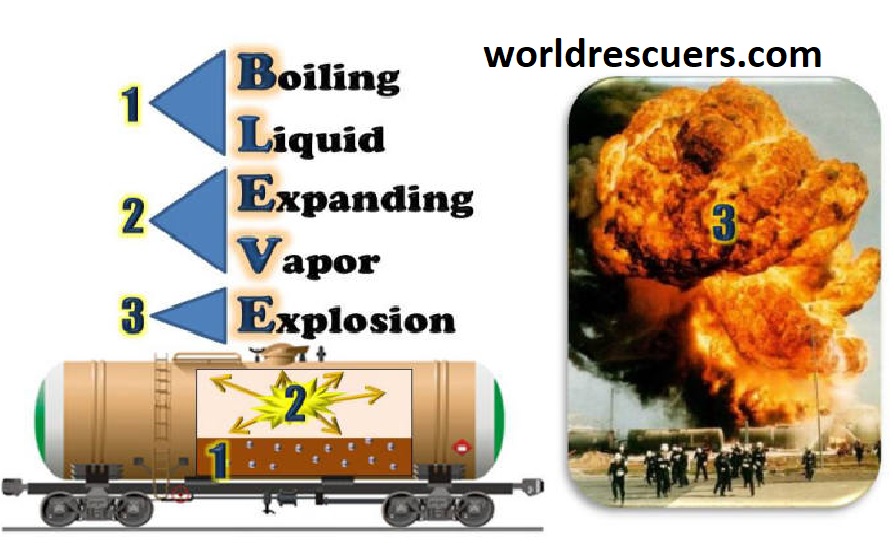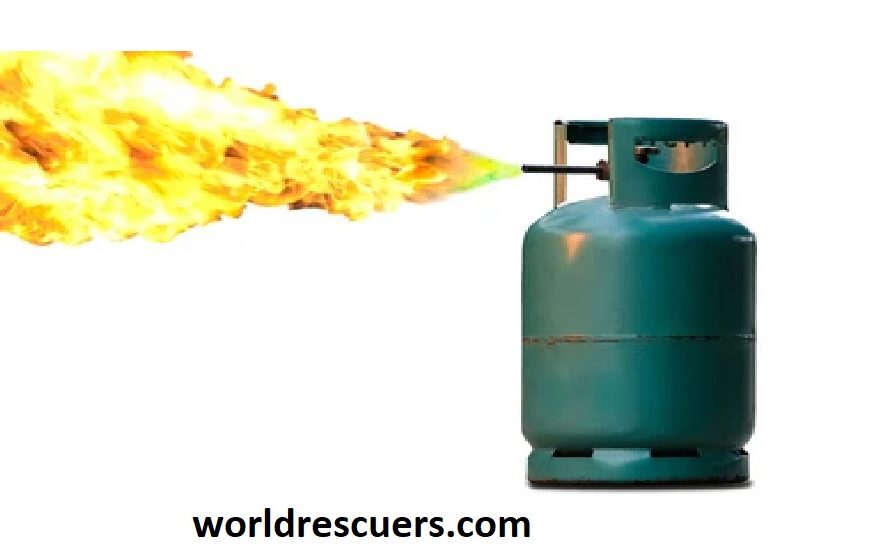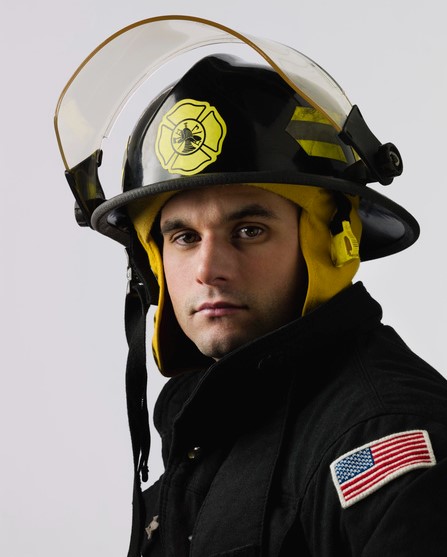
What does b.l.e.v.e. mean?
What does B.l.e.v.e. stand for, “Boiling Liquid Expanding Vapor Explosion.” It is an acronym for a particular type of explosion that can occur when a pressurized vessel containing a boiling liquid (such as propane or gasoline) suddenly ruptures.
A decrease in pressure due to a rupture in the vessel caused by the pressurized boiling liquid results in a massive explosion. This explosion can be incredibly powerful and destructive. It can also cause significant damage to surrounding structures and harm to people nearby the incident.

B.l.e.v.e. explosions are particularly dangerous because they can happen very suddenly with little warning and can cause a lot of damage in a short amount of time. Therefore, it is important to handle and store pressurized containers containing boiling liquids carefully to avoid the risk of a b.l.e.v.e.
What is bleve in LPG?
B.l.e.v.e. in LPG refers to a Boiling Liquid Expanding Vapor Explosion that can occur in a container or tank containing stored liquefied petroleum gas (LPG). LPG is commonly used in residential, commercial, and industrial applications. It is often stored in high-pressure pressurized containers to keep it liquid.

If a pressurized LPG container experiences a sudden rupture or pressure release, the liquid can rapidly boil and expand, leading to a BLEVE. Various factors, such as exposure to heat, mechanical failure, or damage to the vessel or container, can cause this.
B.l.e.v.e. in LPG can be extremely dangerous and cause significant damage and injuries to people and property in the surrounding incident area. It is important to handle and store LPG containers properly and to follow appropriate safety procedures to minimize the risk associated with BLEVE. This includes regular maintenance and inspection of LPG containers or LPG cylinders. The training on safe handling and emergency response procedures of officials in case of a potential BLEVE Hazard is also necessary.
What is bleve caused by?
A variety of following factors can cause a b.l.e.v.e. (Boiling Liquid Expanding Vapor Explosion):
Fire or exposure to high temperatures:
If a container that holds a boiling liquid is exposed to fire or high temperatures sources, the heat can cause the liquid to boil and vaporize. This increases the pressure inside the container and potentially causes it to rupture due to structural damage.
Mechanical failure:
If a container is damaged, corroded, or weakened due to ageing, it may be more prone to failure or rupture. A crack or leak in the container can cause the liquid to vaporize and suddenly release, leading to a b.l.e.v.e.
Overfilling or over-pressurization:
If a container is overfilled with liquid or over-pressurized, it can increase the risk of a b.l.e.v.e. The filling of containers on designed and tested pressures can reduce this risk. This can cause the pressure inside the container to exceed its maximum capacity, leading to a rupture and the rapid release of vapour.
External impact:
An external impact, such as a container collision with another vessel or solid object, can also result in an explosion. Or the explosion in nearby the stored vessels can cause a container to rupture and lead to a b.l.e.v.e.
It is important to properly handle and maintain containers holding boiling liquids to minimize the risk of a BLEVE. This includes regular inspection and maintenance, proper storage, and adherence to safety regulations and protocols.
Is BLEVE an explosion?
Yes, a b.l.e.v.e. (Boiling Liquid Expanding Vapor Explosion) is a type of explosion. It occurs when a container holding a boiling liquid, such as propane or gasoline, ruptures and rapidly releases a large amount of expanding vapour. The rapid expansion of the vapour can create a powerful blast wave. This wave can cause significant damage to surrounding structures and harm to people nearby.
BLEVEs are particularly dangerous because they can happen suddenly and with little warning and quickly release a large amount of energy. It is important to carefully handle and store pressurized containers containing boiling liquids to avoid the risk of a BLEVE. This includes regular maintenance and inspection of the container and following appropriate safety procedures in case of a potential BLEVE.
Process of happening Bleve explosion
A BLEVE explosion (Boiling Liquid Expanding Vapor Explosion) can occur when a container holding a pressurized liquid is exposed to heat, causing the liquid to vaporize and expand rapidly. This can happen, for example, when a propane tank or a tank of liquefied natural gas (LNG) is exposed to fire or extreme heat.
Process
When the temperature of the liquid inside the tank rises above its boiling point, the liquid will begin to vaporize and produce a significant amount of pressure. If the pressure becomes too great, the tank can rupture or explode, releasing a large cloud of flammable vapour that can ignite and cause a further powerful explosion. A phenomenon can further amplify the vapour cloud explosion (VCE) explosion, in which the expanding vapour cloud mixes with air to form a highly explosive mixture. When this mixture reaches an ignition source, such as an open flame or a spark, it can ignite and cause a powerful explosion that can be highly destructive.
BLEVEs are particularly dangerous because they can occur suddenly and without warning, releasing a large amount of flammable vapour that can spread quickly and ignite, causing widespread damage and potentially leading to injuries or fatalities. To prevent BLEVEs, storing and handling pressurized liquids properly and having emergency plans and procedures in case of an accident or fire are important.

Hi, I am John Smit a Captain in Fire Department City of Newyork with over years of experience in the field of Firefighting and HSE. My passion for fire safety started when I was a young boy and witnessed a neighbor’s house go up in flames along with precious lives. Since then, I had dedicated my life to ensuring the safety of buildings, properties, and individuals in case of a fire and medical emergencies.


